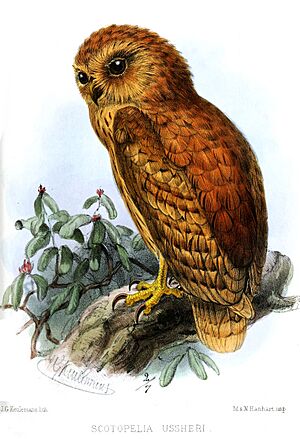Rufous fishing owl facts for kids
Quick facts for kids Rufous fishing owl |
|
|---|---|
 |
|
| Conservation status | |
| Scientific classification |
The rufous fishing owl (Scotopelia ussheri) is a special kind of owl found only in West Africa. It's also called the rufous-backed fishing-owl or Ussher's fishing owl. This owl lives near forest rivers and is quite rare to see.
Contents
About the Rufous Fishing Owl
The rufous fishing owl was first described by an English scientist named Richard Bowdler Sharpe in 1871. It belongs to a group of owls called Scotopelia, which are known as fishing owls. This owl was named after Herbert Taylor Ussher, who helped find the first owl that Sharpe studied.
What Does This Owl Look Like?
The rufous fishing owl is a medium-sized owl. It is about 46 to 51 cm (18 to 20 in) long. This is smaller than another fishing owl, the Pel's fishing owl, which also lives in the same area.
This owl does not have ear tufts, which are the feather tufts that look like ears on some owls. Its face is a pale, light brown color. The feathers on its belly are light with thin dark lines. Its sides might have a bit more of a reddish-brown color. The top parts of its wings have a mix of reddish-brown, creamy-white, and white colors. There are also some dark marks on its back.
Young rufous fishing owls look similar to the adults, especially their wings. However, their first feathers are usually lighter, especially on their bellies. Young owls might also look a bit rounder because their feathers are thicker and fluffier.
The owl's feet and legs are bare, meaning they don't have feathers. They are yellowish-orange. Its beak is bluish-grey, and the skin around its beak (called the cere) is yellowish.
What Does the Rufous Fishing Owl Sound Like?
This owl makes a low, deep sound. It sounds like a moan or a dove's hoot. It can repeat this sound every 15 to 20 seconds for a long time. Sometimes, a pair of owls will hoot together. Scientists have found that these owls respond best to calls during the small rainy season when the moon is full.
Where Does This Owl Live?
The rufous fishing owl lives only in West Africa. You can find it in countries like Ivory Coast, Ghana, Guinea, Liberia, and Sierra Leone. It prefers to live along shady river banks in forests. Its favorite homes are moist lowland forests and mangrove forests, which are forests that grow in salty water.
Even though it lives near the Pel's fishing owl, they use their homes differently. The Pel's fishing owl likes bigger, deeper rivers. But the rufous fishing owl seems to prefer smaller, shallower rivers. This might be why it has also been seen in forests that have grown back after being cut down. As long as there are trees hanging over the streams, the owl can find good spots to fish. It has also been seen in farm areas, which suggests it can adapt to different places more than we thought.
How Does This Owl Behave?
We don't know much about the rufous fishing owl's daily habits. Like other fishing owls, it probably hunts mostly at night. However, it has been seen during the day sometimes. In 2009, a camera trap in Sierra Leone took a picture of one at midday. But no one has seen it hunt during the day, so it likely hunts more at night.
What Does This Owl Eat?
The rufous fishing owl mainly eats small fish. Scientists found catfish in the stomach of an owl from Sierra Leone. It might also eat freshwater crabs and other small creatures.
Reproduction and Life Cycle
In Sierra Leone, these owls have laid eggs in September and October. Young owls that were changing from their baby feathers to adult feathers were seen in Liberia in July. This happens about six months after they leave the nest. Scientists believe that these owls usually have only one chick at a time.
Is This Owl in Danger?
The rufous fishing owl was once thought to be very rare and was listed as endangered. But new studies showed that it's not as rare as people thought. So, in 2011, its status was changed to vulnerable. This means it's still at risk, but not as much as before.
However, this owl is still one of the rarest and least known owls in the world. Its populations are spread out and are still shrinking. This is mainly because of habitat loss, which means their forest homes are being destroyed.


